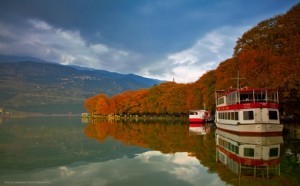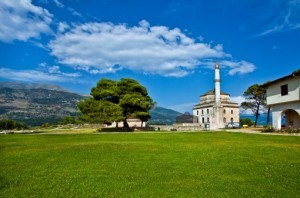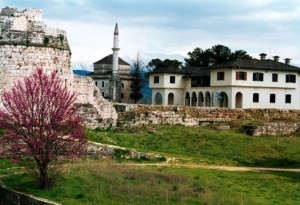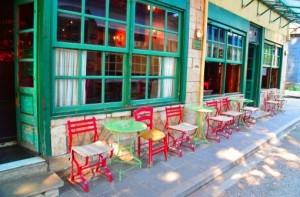Ioannina, the capital of Epirus, spreads out around beautiful Lake Pamvotida. The natural environment, the climate and character of the town are defined by this stretch of water – the area’s trademark. The lake, with its still waters and its small island, is a natural monument, around which the entire area lives and breathes. The strong cultural traditions of the town, home to a number of great novelists and poets, and the artistic and intellectual events which are organized throughout the year, give visitors the opportunity to get to know the roots of the intellectual life of Epirus.
A walk through the city has the feel of a bygone era, full of secret places and legends still living. Wonderful buildings like the House Matei Hussein, the Ottoman mosque of Veli Pasha and the entire historic center of the town are unique attractions.
Ioannina was always multicultural, dominated mainly by Christian, Islamic and Jewish influences. This coexistence of cultural influences is clearly evident in the historic city center. The Stoa Louli arcade is one of the locations where the three communities worked together and prospered. The arcade was originally an inn and then became a mercantile exchange of great importance throughout the whole of Epirus.
The castle town of Ioannina
The imposing castle of Ioannina was built in 528 AD by the Emperor Justinian, and was an ambitious expression of the might of the Byzantine Empire. It is the oldest Byzantine fortress in Greece with significant influence over the history of the town which grew around it. Over the years it evolved into a thriving center with a highly developed intellectual life. Ali Pasha, that enigmatic symbol of Ottoman rule, lived here. His great love for the lady Kyra – Frosini resonates still as an integral part of the history of the town.
The castle is divided into four sections: the outer wall, the northwestern citadel, which is dominated by the Aslan Mosque, the southeast citadel of Itch-Kale and finally the actual castle town – the old, walled town of Ioannina.
With a view of Lake Pamvotida
The routes around the lake offer exquisite scenery and plenty to explore. A tour by car is an experience to suit all kinds of traveler – there is much to see, much to learn about, and there is the serene calming effect of the lake.
Towards the north exit from Ioannina, on the Metsovo arterial road, is the church of Agios Nikolaos ton Kopanon (‘St Nicholas of the Beaters’), named for the women who beat the clothes as they did their washing in the nearby traditional stone watermills by the lake. Tradition has it that Kyra-Frosini, the notorious mistress of Ali Pasha, was imprisoned here.
As the road continues on, it leads to one of the most beautiful caves in Europe, Perama. The cave, a product of karst formation, dates back about one and a half million years. The beauty of the chambers defies description. It seems impossible that the hall of the Cross, with its limestone worshippers, was formed without human intervention, and yet, it is a natural sculpture of truly stunning proportions. The Hall of Legendary Palaces looks like a fairy house.The stalactites projecting from the ceiling look like surprisingly complex yet harmoniously constructed chandeliers. The area around the cave is an ideal spot from which to look out over the lake and feel the magic of nature. The small train that runs from Ioannina to the picturesque village of Perama is a nostalgic choice of transport.
Why “like the Pasha in Ioannina”?
The expression to “live like the Pasha in Ioannina” means that a person is enjoying the absolute best that life has to offer. It is not enough to have the title of ruler; he also has to live in Ioannina. It is the distillation, in colloquial terms, of the idea that Ioannina was always a wealthy and aristocratic city.
The gastronomic pleasures of Ioannina will satisfy the most demanding. The mountains of Epirus provide a wide range of spices and herbs which are freely used to complement the finest basic ingredients. Fish, of course, from the lake, such as eels and trout, are cooked in sophisticated ways, and together with frog’s legs, a special delicacy, are the hallmark of the Ioannina cuisine.
The traditional Ioannina desserts are famous throughout Greece. The famous ‘sker bourek’, or ‘sugar pie’, the exceptionally delicious baklava and the other syrup pastries are but a few of the flavours that are certain to captivate visitors.
One item made only in Ioannina and nowhere else, is an alcohol free liqueur. This completely unique liqueur is based on a mixture of organic vinegar, nectar, fruit syrups, and herbs. It is usually drunk with crushed ice, and you will soon discover, if you try it, that a drink does not have to contain alcohol to be intoxicating. The traditional coffee shops in the town also serve what they call “sherbetia”, or sherbet, which is a kind of sweet wine flavoured with fruit and flowers.
Silver and gold
The silversmith’s art is one of the most important aspects of local culture in Ioannina. The wirework or cast jewelry of Epirus, the exquisite “tzovairia” were famous beyond the Greek territories. The expression “Arta and Ioannina” meant – and is still used to mean – “all the wealth of the earth”.
The beautiful jewelry of Ioannina, of traditional or original modern designs is still synonymous with understated elegance. Delicate earrings, intricate chains, ornate buckles, and silver ornaments are only fragments of the variety of craftwork that visitors can admire in the town’s jewelers’ shops.
How to get there:
The development of the road network has made getting to Ioannina much easier. It takes just 3 hours from Thessaloniki on the Egnatia Highway, and from Athens it can be reached via Patras, on the wonderful route over the Rio Antirrio Bridge.
Public transport also services the access road to the city. There is also the alternative of taking the ferry boat to Igoumenitsa, and from there continuing by car to Ioannina. Epirus is served by frequent air flights to and from the King Pyrrhus Airport.
Source: visitgreece
Ask me anything
Explore related questions








